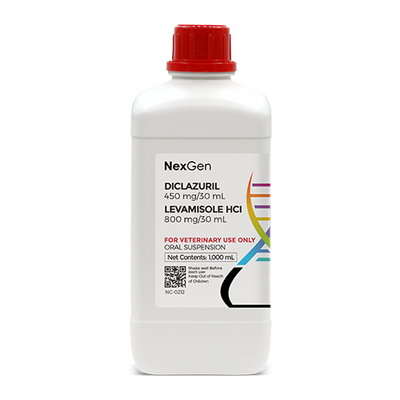
Diclazuril 8.3 %, Oral Suspension, (1000mL)
Login for pricing
- Brand
- Mixlab
- SKU:
- NC-0213
- Product Type:
- Suspension
- Size:
- 1000ml
- Administration:
- Oral
Diclazuril is a member of the triazine class of antiprotozoals.
Background
In the 1960’s and 1970s, a clinical syndrome referred to as “segmental myelitis” was first described based on a studies involving groups of horses in the eastern United States.2 Protozoa were first reported in lesions from horses by researchers in 1974. The syndrome was well-described, but the parasite involved was misidentified as Toxoplasma gondii; later, it became clear due to the illustrations taken from studies that the protozoan causing EPM was in fact Sarcocystis neurona.3 One researcher called the syndrome“equine protozoan encephalomyelitis,”4 which was later standardized to equine protozoal myeloencephalitis, or EPM.
Description and Symptoms
EPM is an extremely debilitating disease that is ubiquitous on horse farms and facilities in the Americas, although only a small percentage of horses that are exposed to the S. neurona organism will develop clinical disease. The S. neurona organism infects horses when they ingest the organism in contaminated feed or water. The definitive host of this organism is the opossum, which passes the organism in its feces.2 EPM presents with a variety of neurologic signs, depending on the infection. Signs can have a subtle, gradual onset, or be acute and severe.
Most commonly, horses with EPM present with asymmetric hindlimb paresis (weakness) and muscle atrophy. Rarely, the first signs may be related to a cranial nerve deficit (blindness, facial nerve deficits) or a focal brain lesion (depression, seizures). Without treatment, EPM will progress to severe paresis (weakness) and possibly recumbency (an inability to rise).3
Where to buy Diclazuril
Diclazuril is available in the U.S. through several pharmaceutical manufacturers and through veterinary custom compounding companies.
FOR RX ONLY: A valid prescription from a licensed veterinarian is required for dispensing this medication.
2Rooney, J.R., Prickett, M.E., Delaney, F.M., Crowe, F.W., 1970. Focal myelitis–encephalitis in horses. CornellVet. 50, 494–501.
3Dubey, J.P. , et. al. A review of Sarcocystis neurona and equine protozoal myeloencephalitis (EPM) Veterinary Parasitology 95 (2001) 89–131.
4Mayhew, I.G., de Lahunta, A., Whitlock, R.H., Pollock, R.V.H., 1976. Equine protozoal myeloencephalitis. In:Proceedings of the 22nd Annual Convention of the American Association of Equine Practitioners, Dallas, TX, November–December, pp. 107–114.




















